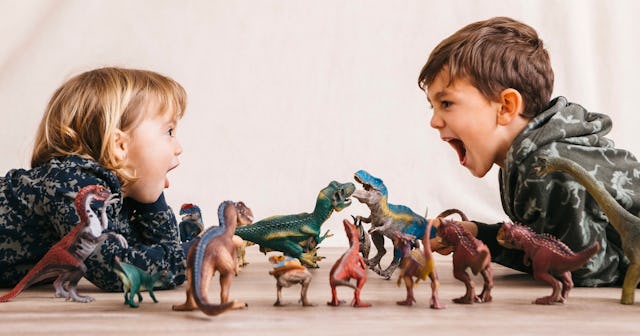Dino-rawr! A Look At The Types Of Dinosaurs That Once Roamed The Earth

Kids (or at least a lot of kids) love learning about dinosaurs. Maybe it’s the fact that they’re essentially monsters, except instead of completely pretending, they once lived in the same places we live today. While that may sound like it would be scary to children, it helps that dinosaurs are long-extinct and not something they need to worry about today. Instead, they can visit what’s left of them (their skeletons) in museums, and can always hold out hope that they might even unearth their own fossil or dinosaur bone while digging holes in the backyard. (Real talk: that sounds like a great idea for a dinosaur craft for kids!) But if it’s been a while since you last read up on dinosaurs and your budding paleontologist is interested in them and wants to learn all about the different types that once existed, here are some of the big ones (sorry) to know.
Types of Dinosaurs
Theropods
The first category of dinosaurs is theropods, which were carnivores, meaning that they ate meat. Theropods had strong legs and three-toed bird-like feet with sharp claws. They were also known for having short arms — including T. Rex.
Other examples of theropods include:
- Albertosaurus
- Allosaurus
- Baryonyx
- Carnotaurus
- Coelophysis
- Compsognathus
- Deinonychus
- Giganotosaurus
- Megalosaurus
- Ornithomimus
- Oviraptor
- Saurophaganax
- Spinosaurus
- Tyrannosaurus
- Tyrannotitan
- Velociraptor
- Yangchuanosaurus
Sauropods
Sauropods had small heads, but long necks and long tails, and walked on all four feet. They were also herbivores — meaning they didn’t eat meat.
Some examples of sauropods include:
- Apatosaurus
- Brachiosaurus
- Diplodocus
- Giraffatitan
- Jobaria
- Macrurosaurus
- Mamenchisaurus
- Seismosaurus
- Zigongosaurus
Stegosaur
Stegosaurs — like the Stegosaurus — were known for their bony plates and spikes, and how slowly they got around.
Examples of this medium-sized dinosaur include:
- Kentrosaurus
- Stegosaurus
- Chialingosaurus
- Wuerhosaurus
- Tuojiangosaurus
- Chungkingosaurus
- Huayangosaurus
- Yingshanosaurus
- Gigantspinosaurus
- Jiangjunosaurus
Ankylosaur
Ankylosaurs were small-to-medium-sized dinosaurs with bodies covered in flexible bony slabs or plates.
Examples of Ankylosaurs include:
- Ankylosaurus
- Minmi
- Euoplocephalus
- Nodosaurus
- Edmontonia
- Sauropelta
- Ankylosaurus
- Euoplocephalus
- Pinacosaurus
- Polacanthus
- Gastonia
- Mymoorapelta
Cerapod
Cerapod dinosaurs had four legs and three horns and usually lived in large herds. Some had a bony frill around their face. Others had parrot-like beaks. They range in size from small to large. Examples of Cerapods include:
- Psittacosaurus
- Styracosaurus
- Triceratops
Ornithopod
Ornithopods walked and ran on their two hind legs and had bird-like feet. They came in all sizes, from small to quite large. Examples of Ornithopods include:
- Corythosaurus
- Lesothosaurus
- Iguanodon
- Parasaurolophus
Pachycephalosaur
Pachycephalosaurs were dinosaurs with thick skulls that walked (slowly) on their hind legs and lived in herds. Examples of Pachycephalosaurs include:
- Stegoceras
- Pachycephalosaurus
- Prenocephale
Dinosaur Names and Meanings
- Albertosaurus — Albert lizard
- Ankylosaurus — stiff lizard
- Baryonyx — heavy claw
- Brachiosaurus — arm lizard
- Carnotaurus — meat-eating bull
- Compsognathus — elegant jaw
- Corythosaurus — helmet lizard
- Diplodocus — double-beam lizard
- Edmontosaurus — lizard from Edmonton
- Giraffatitan — giraffe titan
- Iguanodon — iguana tooth
- Maiasaura — good mother lizard
- Megalosaurus — great lizard
- Seismosaurus — earth-shaking lizard
- Stegosaurus — roofed lizard
- Tyrannosaurus — tyrant lizard
- Velociraptor — swift plunderer
- Zigongosaurus — Zingong lizard
Dinosaur Facts
- Some scientists believe that there are still many types of dinosaurs that haven’t been discovered yet.
- The first dinosaur to be officially named was the Megalosaurus, back in 1824.
- Dinosaur remains were first discovered in North America on the upper Missouri River in 1854.
- Prior to dinosaurs, other reptiles like archosaurs and therapsids existed.
- Most dinosaurs that walked on two legs also ate meat.
- Dinosaur remains have been found on every continent, including Antarctica.
- The biggest dinosaur eggs were about 19 inches long.
- The smallest dinosaur eggs were about 0.7 inches — smaller than the diameter of a penny.
- Dinosaurs lived on Earth for about 160 million years.
- There were approximately 700 known species of extinct dinosaurs.
- Someone who studies dinosaurs is called a paleontologist.
- The largest dinosaurs were herbivores, meaning that they ate plants and not meat.
- Modern-day birds — like the ones in your backyard — are descendants of dinosaurs.
- Technically, pterodactyls were not dinosaurs: they were flying reptiles that lived at the same time as dinosaurs, but by definition, they do not fall into the same category.
- Dinosaurs are thought to have gone extinct around 65 million years ago.
- The word “dinosaur” comes from Greek words meaning “terrible lizard,” and was coined in 1842 by English paleontologist Richard Owen.
- Stegosauruses have very small brains compared to the rest of their bodies. It’s about the size of a tangerine or a dog’s brain. Stegosauruses were about 21 feet long and sometimes grew up to 30 feet!
- The most miniature dinosaur skeleton ever found was the baby mussaurus. It’s also called a mouse lizard and was small enough to fit in a book bag.
This article was originally published on